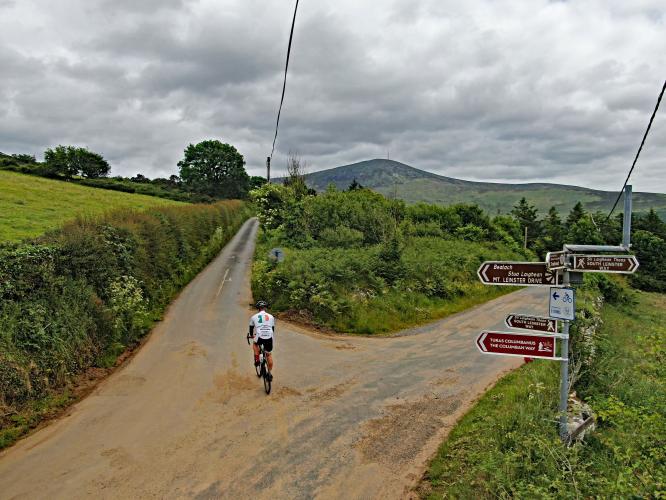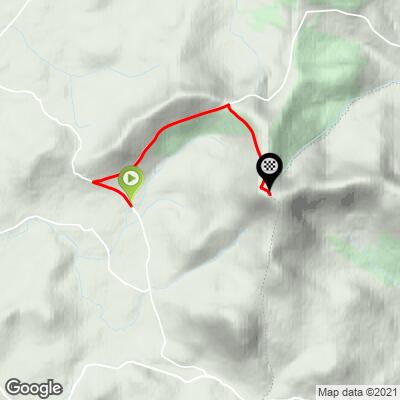![Cycling Mount Leinster West, Ireland bike parked against guardrail looking down over Irish farmland below; two-lane roadway]()
Cycling Mount Leinster West, Ireland
Ride 7.6 kilometers gaining 685 meters at 9.1% average grade.
Mount Leinster is an amazing bike climb and the hardest in Ireland when approached from the west.
![Cycling Mount Leinster West, Ireland photo collage highlights scenery on the hardest bike climb in Ireland; views of farmland, windmills, and sheep]()
Mt. Leinster, West. It’s not every day one gets to ride the steepest climb of an entire country. The steep slopes of Mt. Leinster West are not only crowned as the toughest of Ireland, but they also offer a nearly non-trafficked and very scenic (albeit brutal and relentless) ride to the very summit of Mt. Leinster at 2,566 feet of elevation. Not a single car passed me when I rode this climb. It was just me, the thick bovine, and a number of free roaming sheep. You’ll turn right onto a well marked access road at kilometer 5 that is closed to auto traffic. There at the turnoff is a large parking lot with picnic tables which is an option for leaving your car if you’ve driven to the climb. At the summit, enjoy some of the best views available in this part of Ireland and take in that descent back down - it’s a fast and fun one!
![Cycling Mount Leinster West, Ireland cattle guard, old sign for cattle guard, colorful wildflowers]()
The following Climb Summary is from PJAMM ambassador Stephen Rochford of Longwood, Colorado and Meath, Ireland. (Stephen is the cyclist in the featured image for this climb page.)
Mount Leinster West - The toughest climb in Ireland?
Ireland doesn't have really high mountains, most of our climbs are little more than foothills compared to the Alps, Pyrenees, Dolomites, or any of the great ranges of the Americas. Many of our most famous climbs, such as the Sally Gap, are far more notable for their scenery than difficulty.
![Cycling Mount Leinster West, Ireland photo collage shows brown cows grazing in pasture, sign warns "beware of bull"]()
Plenty of pastureland and grazing cattle in view during our ride.
Mount Leinster is a spectacular exception to this. There are several approaches to the mountain but they all converge at the Nine Stones car park where the road up to the TV antenna starts. The mountain forms part of the Blackstairs Mountain Range, a small range that rises above the flat plains of the southeast Irish countryside.
![Cycling Mount Leinster West, Ireland PJAMM Cyclist rides at fork in road, sharp right turn onto Mt. Leinster Drive]()
Sharp right onto Mt. Leinster Drive at kilometer 1.1.
![Cycling Mount Leinster West, Ireland photo collage shows views along the middle of the climb: big horn sheep, blue cloudy sky, narrow one-lane roadway]()
Views along the middle part of the climb.
![Cycling Mount Leinster West, Ireland Nine Stones monument and parking lot]()
Exceptional views from Nine Stones at the car park and gate at kilometer 5.
The Nine Stones are believed to be placed in commemoration of nine shepherds lost on the mountain in a distant winter storm.
![Cycling Mount Leinster West, Ireland gate across from Nine Stones monument and parking lot; sheep cross the roadway]()
Turn right at the gate just across from Nine Stones.
The final 2.7 kilometers of this brutal climb average 13%.
![Cycling Mount Leinster West, Ireland photo collage shows aerial drone view of end portion of climb; PJAMM Cyclist rides on long stretches of two-lane roadway; green hillsides surround]()
Starting in the village of Borris, you have about five kilometers of rolling lanes through the countryside to get the legs warmed up. The roads are in fairly good condition and are well signposted as part of the Nine Stones Cycling Route, or the Mount Leinster Drive. From once we reach the junction at Tomduff the proper climbing starts. The Strava segment says that it is 6.4km at 10% grade, however it is probably better to split this into two parts. The first section is a little over 3.5 kilometers with an average gradient of 7.5%. There are a few short ramps in this part where the road tips up into the low teens, but generally speaking it is fairly steady. When we get to the Nine Stones Car Park things change pretty quickly. Once we go through the gate the first few hundred meters at 6-7% are through the pine forest, but the trees soon disappear and you are left exposed to the elements as you crawl slowly up the shoulder of the mountain. The road straight away pitches up to 15%, and for the next 2.5 kilometers it rarely goes below that. There is a section where you get down to between 10 and 12%, and this feels like a false flat because either side of it, you’ll be scraping close to 20%. The last kilometer is the toughest. It really is just at a horrible angle and you are at close to your maximum effort just trying to keep moving forward.
![Cycling Mount Leinster West, Ireland photo collage shows climb finish, Mount Leinster Television Transmitter]()
Finish at the Mount Leinster Television Transmitter.
While the roadway surface is in good condition for climbing, it is not a great road to descend. The long, straight stretch and -15% mean things can get very fast really quickly and there are plenty of small bumps and irregularities that could put an end to your fun in a flash.
One of the most torturous aspects of this climb is how straight the majority of the route to the top is. The pain is right there in front of you all the way. It is only in the last 250 meters that there is a chicane that obscures your view of the very top of the climb at the gates of the mast. As Mount Leinster is the highest point in the Blackstairs Mountain Range, the views all the way up from the car park are magnificent, weather permitting. You really need to do this climb on a clear day to appreciate it fully.
![Cycling Mount Leinster West, Ireland PJAMM Cyclist stands on large boulder at climb finish giving a thumbs up]()
Climb Finish.
So is this Ireland's toughest climb? In a word, Yes.
Truskmore has a longer tough section, four kilometers at 10.4% (as opposed to 2.5 kilometers at 13.4%), and plenty of high percentage ramps, but as a whole climb Mount Leinster trumps it for pure sustained brutality.
It's a beast.
![]()
That’s a wrap!

 We've partnered with Sherpa-Map.com to bring you the best route planning tool. With a PRO Membership you can use this climb as a reference when creating your route.
We've partnered with Sherpa-Map.com to bring you the best route planning tool. With a PRO Membership you can use this climb as a reference when creating your route. 



